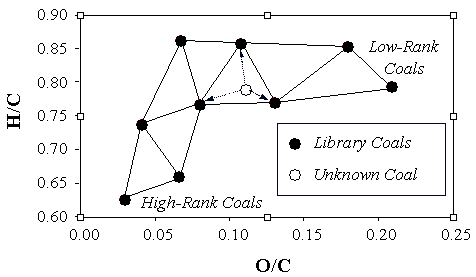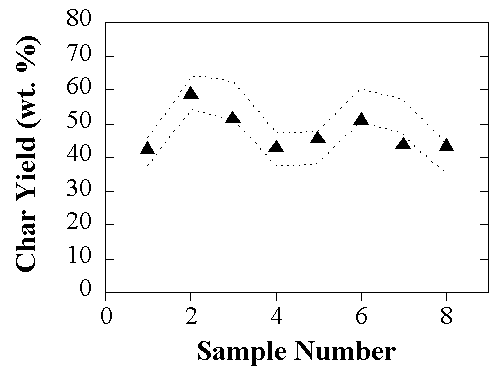|
|
|
|
Functional-Group, Depolymerization,
Vaporization, Cross-linking Model
|
|
coal | |
|
biomass | |
|
waste materials (e.g., waste tires) |
The following information provided as a function of extent of devolatilization (e.g., pyrolysis time):
|
Gas, tar, and char yields | |
|
Elemental composition of gas, tar, and char | |
|
Molecular weight distribution of tar | |
|
Information on coal softening and fluidity | |
|
Detailed speciation and quantification of volatile products: |
Tar
H2O
CO2
CO
CH4
C2H4
NH3
HCN
COS
SO2
For biomass, additionally:
formaldehyde
acetaldehyde
formic acid
acetic acid
methanol
phenol
acetone
levoglucosan
|
The effect of pressure taken into account | |
|
Capability for integration with Computational Fluid Dynamics (CFD) codes |
FLUENT
PCGC-2 (pulverized coal combustion/gasification - Brigham Young University)
AIOLOS (University of Stuttgart)
MBED-1 (fixed beds - Brigham Young University)
FBED-1 (fixed beds - Brigham Young University)
MFIX (fluidized beds – U.S. Department of Energy)
|
Stand-alone versions available on multiple platforms |
PC (DOS, Windows 95 / 98 / NT)
UNIX
Macintosh (under development)
|
Extensive customer support available from the model developer, Advanced Fuel Research, Inc. (includes TG-FTIR characterization of unusual | |
|
Model Input |
Elemental composition of coal or biomass
Pyrolysis temperature as a function of time
In the case of biomass, some coals, and non-standard feedstocks, TG-FTIR analysis (a thermogravimetric analyzer combined with Fourier transform infrared analysis of evolving products) – available from Advanced Fuel Research, Inc.
|
Coal-conversion processes: pyrolysis, gasification, combustion, liquefaction | |
|
Coal switching | |
|
Coal blending | |
|
Co-firing of biomass and coal | |
|
Biomass conversion: pyrolysis, gasification, and combustion |
The modeling approach used in FG-DVC is phenomenological in nature. A suite of well-characterized coals was selected to form an FG-DVC database (library coals), and pyrolysis behavior of these coals was extensively studied using TG-FTIR analysis, pyrolysis Field Ionization Mass Spectrometry (FIMS), Gieseler fluidity, solvent swelling and solvent extraction. Based on this information, three FG-DVC input files were created for each library coal: (1) kinetic file; (2) composition file; and (3) polymer file. The first two files describe the kinetics of gas-product evolution and the amounts of precursor material for each volatile species. A set of independent, first-order reactions with Gaussian activation-energy distributions is used for the kinetic model. The polymer input file contains information on the coal’s swelling and fluid behavior. The library coals can be represented as a network of grid nodes in the so-called van Krevelen diagram (a plot of H/C versus O/C atomic ratios). The required three FG-DVC input files can be generated for any coal, as illustrated in Figure 1. Elemental composition data for an untested coal are plotted in the van Krevelen diagram, and input parameters are interpolated from among input parameters of the three nearest library coals (triangular interpolation). In this way, elemental composition is the only input information that is needed to run the FG-DVC code. For unusual feedstocks, custom input files can be created at AFR.

Figure 1. Illustration of an interpolation scheme used
to create FG-DVC input files for a coal with an unknown pyrolysis behavior.
The FG-DVC model has been extensively validated against experimental data, and more detailed information on model validation can be found in The FG-DVC Model Description and Validation fact sheet. For the sake of illustration, results of blind model-prediction tests are shown in Figure 2. An independent testing program was carried out on behalf of Electric Power Research Institute (EPRI), and the tests involved drop-tube pyrolysis experiments performed at PowerGen. A set of eight international coals was used, and AFR was provided only with their proximate and ultimate analyses in addition to the nominal pyrolysis conditions (a linear temperature ramp at 2 x 104 K/s from room temperature to 1613 K, followed by an isothermal treatment at 1613 K for 150 milliseconds). The dotted lines in Figure 2 indicate the approximate range of uncertainty in experimental data, and solid symbols represent the FG-DVC model predictions. It can be seen that the agreement is good.

Figure 2. Comparison of PowerGen drop-tube pyrolysis data with FG-DVC model predictions. Dotted lines indicate the uncertainty limits of experimental data, and solid symbols represent model predictions.
The following FG-DVC fact sheets are available:
|
The FG-DVC Model Description and Validation | |
|
A List of Publications on the FG-DVC Model | |
|
FG-DVC Ordering Information |
Inquiries about the FG-DVC model should be directed to Dr. Marek A. Wójtowicz, Manager, Hydrocarbons Group, Advanced Fuel Research, Inc., East Hartford, CT 06108, USA; tel. +1 (860) 528-9806 ext. 142, fax +1 (860) 528-0648, e-mail: marek@AFRinc.com.
A partial list of laboratories which have used the FG-DVC Model.
U.S.A.
| Name | Location |
| ABB - Power Plant Laboratories | Windsor, CT |
| Riley Stoker Corporation | Worcester, MA |
| Babcock and Wilcox Co. | Alliance, OH |
| Foster Wheeler Development Corp. | Livingston, NJ |
| Factory Mutual Research Corp | Norwood, MA |
| BOC Group Technical Center | Murray Hill, NJ |
| CRS Sirrine Engineers, Inc. | Greenville, SC |
| Bechtel Corp | San Francisco, CA |
| Department of Energy, NETL | Morgantown, WV |
| Department of Energy, NETL | Pittsburgh, PA |
| National Institute of Standards and Technology | Gaithersburg, MD |
| National Renewable Energy Laboratory | Golden, CO |
| FAA Technical Center | Atlantic City, NJ |
| Brown University | Providence, RI |
| Brigham Young University | Provo, UT |
| Virginia Polytechnic Institute | Blacksburg, VA |
| Oregon State University | Corvallis, OR |
| University of Utah | Salt Lake City, UT |
. .
Overseas
| Name | Location |
| Institut Français du Pétrole | Rueil - Malmaison, France |
| AEA Technology | Oxfordshire, UK |
| DMT Gesellschaft | Essen, Germany |
| Insituto de Carboquimica | Zaragoza, Spain |
| Instituto Nacionel Del Carbon | Oviedo, Spain |
| Reatech | Roskilde, Denmark |
| Swedish National Testing and Research Institute | Boras, Sweden |
| CSIRO | Sydney, Australia |
| Institute of Coal Chemistry | Shanxi, China |
| Technical University of Denmark | Lyngby, Denmark |
| Technische Universitat Graz | Graz, Austria |
| University of Stuttgart | Stuttgart, Germany |
| Imperial College | London, UK |
| University of Leeds | Leeds, UK |
| University of Newcastle | Callaghan, Australia |
| Monash University | Mulgrove, Australia |
| University of Kyoto | Kyoto, Japan |
| Kyushu University | Fukuoka, Japan |
| Hokkaido University | Sapporo, Japan |
| Tohoku University | Sendai, Japan |
| Åbo Akademi University | Turku, Finland |
| Ruhr Universität | Bochum, Germany |
| Universität Karlsruhe | Karlsruhe, Germany |
| Bandung Institute of Technology | Bandung, Indonesia |
| Swiss Federal Institute of Technology | Zurich, Switzerland |
| Technical University of Aachen | Aachen, Germany |
|
For More Information Contact: This web site was designed and created by Karin Dutton, Advanced Fuel Research, Inc. |